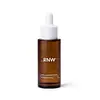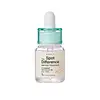What's inside
What's inside
 Key Ingredients
Key Ingredients

 Benefits
Benefits

 Concerns
Concerns

 Ingredients Side-by-side
Ingredients Side-by-side

Water
Skin ConditioningMethylpropanediol
SolventAlcohol
Antimicrobial1,2-Hexanediol
Skin ConditioningGlycerin
Humectant4-Terpineol
MaskingLactoferrin
Skin ConditioningMadecassoside
AntioxidantCentella Asiatica Extract
CleansingAllantoin
Skin ConditioningCeramide NP
Skin ConditioningAlgae Extract
EmollientEclipta Prostrata Leaf Extract
Skin ConditioningFicus Carica Fruit Extract
HumectantSalix Alba Bark Extract
AstringentOriganum Vulgare Leaf Extract
Skin ConditioningChamaecyparis Obtusa Leaf Extract
Skin ConditioningCinnamomum Cassia Bark Extract
MaskingPortulaca Oleracea Extract
Skin ConditioningScutellaria Baicalensis Root Extract
AstringentLactobacillus/Soybean Ferment Extract
Skin ConditioningHydrogenated Lecithin
EmulsifyingCamellia Sinensis Leaf Water
MaskingPolyglyceryl-10 Stearate
Skin ConditioningPolyglyceryl-10 Oleate
Skin ConditioningButylene Glycol
HumectantDipropylene Glycol
HumectantAcrylates/C10-30 Alkyl Acrylate Crosspolymer
Emulsion StabilisingTromethamine
BufferingDisodium EDTA
Fructooligosaccharides
HumectantBeta-Glucan
Skin ConditioningHydrolyzed Hyaluronic Acid
HumectantCarbomer
Emulsion StabilisingPalmitoyl Pentapeptide-4
Skin ConditioningWater, Methylpropanediol, Alcohol, 1,2-Hexanediol, Glycerin, 4-Terpineol, Lactoferrin, Madecassoside, Centella Asiatica Extract, Allantoin, Ceramide NP, Algae Extract, Eclipta Prostrata Leaf Extract, Ficus Carica Fruit Extract, Salix Alba Bark Extract, Origanum Vulgare Leaf Extract, Chamaecyparis Obtusa Leaf Extract, Cinnamomum Cassia Bark Extract, Portulaca Oleracea Extract, Scutellaria Baicalensis Root Extract, Lactobacillus/Soybean Ferment Extract, Hydrogenated Lecithin, Camellia Sinensis Leaf Water, Polyglyceryl-10 Stearate, Polyglyceryl-10 Oleate, Butylene Glycol, Dipropylene Glycol, Acrylates/C10-30 Alkyl Acrylate Crosspolymer, Tromethamine, Disodium EDTA, Fructooligosaccharides, Beta-Glucan, Hydrolyzed Hyaluronic Acid, Carbomer, Palmitoyl Pentapeptide-4
Water
Skin ConditioningGlycerin
HumectantPropanediol
Solvent1,2-Hexanediol
Skin ConditioningGlycereth-26
HumectantNiacinamide
SmoothingCaprylic/Capric Triglyceride
MaskingAloe Barbadensis Leaf Extract
EmollientAlthaea Rosea Flower Extract
Skin ConditioningLaminaria Japonica Extract
Skin ProtectingEclipta Prostrata Leaf Extract
Skin ConditioningCentella Asiatica Extract
CleansingFicus Carica Fruit Extract
HumectantUlmus Davidiana Root Extract
Skin ConditioningAmaranthus Caudatus Seed Extract
Skin ConditioningCamellia Sinensis Leaf Extract
AntimicrobialMonarda Didyma Leaf Extract
Skin ConditioningHydrangea Macrophylla Leaf Extract
Skin ConditioningMentha Aquatica Extract
TonicSasa Quelpaertensis Extract
Skin ConditioningMelaleuca Alternifolia Leaf Extract
PerfumingMelia Azadirachta Leaf Extract
Skin ConditioningEclipta Prostrata Extract
Skin ConditioningCinnamomum Camphora Leaf Extract
MaskingCryptomeria Japonica Leaf Extract
HumectantPinus Pinaster Bark/Bud Extract
AntimicrobialRosmarinus Officinalis Leaf Oil
MaskingHydrogenated Lecithin
EmulsifyingChamaecyparis Obtusa Water
MaskingTrehalose
HumectantOctyldodeceth-16
EmulsifyingAcrylates/C10-30 Alkyl Acrylate Crosspolymer
Emulsion StabilisingTromethamine
BufferingC12-14 Pareth-12
EmulsifyingButylene Glycol
HumectantXanthan Gum
EmulsifyingDisodium EDTA
Ceramide NP
Skin ConditioningFructooligosaccharides
HumectantBeta-Glucan
Skin ConditioningHydrolyzed Hyaluronic Acid
Humectant4-Terpineol
MaskingGlycyrrhiza Glabra Rhizome/Root
EmollientMoringa Oleifera Seed Oil
EmollientGlycolic Acid
BufferingSalicylic Acid
MaskingEthylhexylglycerin
Skin ConditioningWater, Glycerin, Propanediol, 1,2-Hexanediol, Glycereth-26, Niacinamide, Caprylic/Capric Triglyceride, Aloe Barbadensis Leaf Extract, Althaea Rosea Flower Extract, Laminaria Japonica Extract, Eclipta Prostrata Leaf Extract, Centella Asiatica Extract, Ficus Carica Fruit Extract, Ulmus Davidiana Root Extract, Amaranthus Caudatus Seed Extract, Camellia Sinensis Leaf Extract, Monarda Didyma Leaf Extract, Hydrangea Macrophylla Leaf Extract, Mentha Aquatica Extract, Sasa Quelpaertensis Extract, Melaleuca Alternifolia Leaf Extract, Melia Azadirachta Leaf Extract, Eclipta Prostrata Extract, Cinnamomum Camphora Leaf Extract, Cryptomeria Japonica Leaf Extract, Pinus Pinaster Bark/Bud Extract, Rosmarinus Officinalis Leaf Oil, Hydrogenated Lecithin, Chamaecyparis Obtusa Water, Trehalose, Octyldodeceth-16, Acrylates/C10-30 Alkyl Acrylate Crosspolymer, Tromethamine, C12-14 Pareth-12, Butylene Glycol, Xanthan Gum, Disodium EDTA, Ceramide NP, Fructooligosaccharides, Beta-Glucan, Hydrolyzed Hyaluronic Acid, 4-Terpineol, Glycyrrhiza Glabra Rhizome/Root, Moringa Oleifera Seed Oil, Glycolic Acid, Salicylic Acid, Ethylhexylglycerin
 Reviews
Reviews

Ingredients Explained
These ingredients are found in both products.
Ingredients higher up in an ingredient list are typically present in a larger amount.
1,2-Hexanediol is a synthetic liquid and another multi-functional powerhouse.
It is a:
- Humectant, drawing moisture into the skin
- Emollient, helping to soften skin
- Solvent, dispersing and stabilizing formulas
- Preservative booster, enhancing the antimicrobial activity of other preservatives
4-Terpineol is the main component of tea tree oil. It has antibacterial, antioxidant, and anti-inflammatory properties.
This ingredient is potent at killing bacteria, making it an effective acne treatment. According to the book Journal of Profiles of Drug Substances, it helps in reducing acne-causing bacteria such as Propionibacterium acnes.
While tea tree has been found to help soothe inflammation and redness, it can also cause sensitivity and irritation in some people.
Research shows irritation usually occurs when using pure oil and not from cosmetic products.
This ingredient can be derived from several parts of the tea tree plant: leaves, branches, and bark.
Learn more about 4-TerpineolAcrylates/C10-30 Alkyl Acrylate Crosspolymer is a synthetic polymer. It is used to thicken and improve the texture of products. Due to its properties, it can prevent water and oil ingredients from separating.
Beta-Glucan is a polysaccharide. It can be derived from the cell walls of seaweed, oats, yeast, and fungi. It hydrates the skin and helps boost your skin's natural barrier.
As an antioxidant, beta-glucan helps fight free-radicals. Free-radicals are molecules that may damage your skin cells, such as pollution.
Studies show this ingredient may be an effective wrinkle reducer as it can deeply penetrate into skin. It has also been show to help with wound healing.
Learn more about Beta-GlucanButylene Glycol (or BG) is used within cosmetic products for a few different reasons:
Overall, Butylene Glycol is a safe and well-rounded ingredient that works well with other ingredients.
Though this ingredient works well with most skin types, some people with sensitive skin may experience a reaction such as allergic rashes, closed comedones, or itchiness.
Learn more about Butylene GlycolCentella Asiatica Extract (Centella) is derived from an herb native to Southeast Asia. It is famous for its anti-inflammatory and soothing properties.
Centella is rich in antioxidants and amino acids, such as Madecassic Acid and Asiaticoside.
Studies show the compounds in centella help with:
The combination of all these properties makes centella effective at soothing, hydrating, and protecting the skin.
Other great components of centella include Vitamin A, vitamin C, several B vitamins, and Asiatic Acid.
Fun fact: Centella has been used as a medicine and in food for many centuries. As a medicine, it is used to treat burns, scratches, and wounds.
Learn more about Centella Asiatica ExtractCeramide NP is a type of ceramide and formally known as ceramide 3.
Ceramides are intercellular lipids naturally found in our skin that bonds dead skin cells together to create a barrier. They are known for their ability to hold water and thus are a great ingredient for dry skin.
Ceramides are an important building block for our skin barrier. A stronger barrier helps the skin look more firm and hydrated. By bolstering the skin ceramides act as a barrier against irritating ingredients. This can help with inflammation as well.
If you would like to eat ceramides, sweet potatoes contain a small amount.
Read more about other common types of ceramides here:
Ceramide AP
Ceramide EOP
Disodium EDTA plays a role in making products more stable by aiding other preservatives.
It is a chelating agent, meaning it neutralizes metal ions that may be found in a product.
Disodium EDTA is a salt of edetic acid and is found to be safe in cosmetic ingredients.
Learn more about Disodium EDTAEclipta Prostrata Leaf Extract comes from the false daisy plant. False daisy contains antioxidant compounds such as flavonoids.
One study found false daisy to absorb UVA and UVB radiation. However, this should not replace your sunscreen.
False daisy is used in both traditional medicines and foods throughout Southeast Asia and India.
Learn more about Eclipta Prostrata Leaf ExtractFicus Carica Fruit Extract comes from the fruit known as the fig. Figs are rich in antioxidants and helps hydrate the skin.
Figs also contain fatty acids and Vitamins A, B1, and B2.
As a humectant, figs are able to draw moisture from the air to your skin. This helps keep your skin hydrated.
Learn more about Ficus Carica Fruit ExtractFructooligosaccharides is an alternative sweetener. It is often derived from the blue agave plant.
This ingredient is a prebiotic and helps to hydrate the skin. Emerging studies are also showing fructooligosaccharides to have antioxidant properties.
As a humectant, Fructooligosaccharides helps draw moisture to the skin, helping to hydrate the skin.
Bananas, onions, garlic, asparagus, jícama, and leeks also contain fructooligosaccharides.
Learn more about FructooligosaccharidesGlycerin is already naturally found in your skin. It helps moisturize and protect your skin.
A study from 2016 found glycerin to be more effective as a humectant than AHAs and hyaluronic acid.
As a humectant, it helps the skin stay hydrated by pulling moisture to your skin. The low molecular weight of glycerin allows it to pull moisture into the deeper layers of your skin.
Hydrated skin improves your skin barrier; Your skin barrier helps protect against irritants and bacteria.
Glycerin has also been found to have antimicrobial and antiviral properties. Due to these properties, glycerin is often used in wound and burn treatments.
In cosmetics, glycerin is usually derived from plants such as soybean or palm. However, it can also be sourced from animals, such as tallow or animal fat.
This ingredient is organic, colorless, odorless, and non-toxic.
Glycerin is the name for this ingredient in American English. British English uses Glycerol/Glycerine.
Learn more about GlycerinHydrogenated Lecithin is created from the hydrogenation of lecithin (a group of phospholipids). Hydrogenation is a chemical reaction between hydrogen and another element.
This ingredient is an emollient and emulsifier. As an emollient, it helps soften skin by trapping moisture within. As an emulsifier, it prevents oil and water ingredients from separating.
Hydrolyzed Hyaluronic Acid is a form of hyaluronic acid. It is created by the hydrolysis of hyaluronic acid with a high molecular weight. Once created, Hydrolyzed Hyaluronic Acid has a low molecular weight.
Low molecular weight HA has been shown to hydrate and increase elasticity of the skin. Increasing elasticity is also associated with reduction of wrinkle depth.
One study found topical low molecular weight hyaluronic acid may be considered for the treatment of rosacea in the adult population. However, we always recommend speaking with a professional about your skin concerns.
Hyaluronic acids are a humectant. This means they draw moisture from the air. Hyaluronic acids help moisturize, soothe, and protect the skin.
Read more about other common forms of hyaluronic acid:
Learn more about Hydrolyzed Hyaluronic AcidTromethamine helps balance the pH and improve the texture of a product. It is synthetically created.
As an emulsifier, Tromethamine prevents oil and water ingredients from separating. This helps stabilize the product and elongate a product's shelf life. Tromethamine also makes a product thicker.
Tromethamine helps balance the pH level of a product. Normal pH level of skin is slightly acidic (~4.75-5.5). The acidity of our skin is maintained by our glands and skin biome. Being slightly acidic allows our skin to create an "acid mantle". This acid mantle is a thin barrier that protects our skin from bacteria and contaminants.
Oral Tromethanmine is an anti-inflammatory drug but plays the role of masking, adding fragrance, and/or balancing pH in skincare.
1,3-Propanediol, 2-amino-2-(hydroxymethyl)-
Learn more about TromethamineWater. It's the most common cosmetic ingredient of all. You'll usually see it at the top of ingredient lists, meaning that it makes up the largest part of the product.
So why is it so popular? Water most often acts as a solvent - this means that it helps dissolve other ingredients into the formulation.
You'll also recognize water as that liquid we all need to stay alive. If you see this, drink a glass of water. Stay hydrated!
Learn more about Water